传喜法师一行朝圣缅甸圣地——风动石佛塔(图文版)
在这个虔诚信佛的国度里(缅甸),有许多的佛教圣地。每年都有许多人,不辞辛苦地从各地远赴而来,领受佛陀智慧的加持,以此清净自己的身心。位于缅甸孟邦境内的风动石佛塔,地处仰光市区约200英里的地方,开车需要4到5个小时的时间,人们到达山脚后,因为道路狭窄,只能容许一辆车通过,并且非常的陡峭蜿蜒,因此需要换乘当地的敞篷皮卡车才能到达山顶。据当地人介绍,如果不是一百多年前这块风动石被重新发现,很少会有人来到这个荒僻无人的地方。
远远看去,风动石是矗立在悬崖边上的一块巨石,与地面接触面积很小。大风吹过时甚至会随风摇动,但却不会坠落。以前在这石头下面会有个削得很小的竹片,放在石头下面,然后这里的人会去扶动这个石头,竹片会在那边拨动,那是我亲眼见过的。这个证明什么?就是证明说这个金塔跟地面是隔离的,它不是粘在一起的,这是我还有很多人都见过。
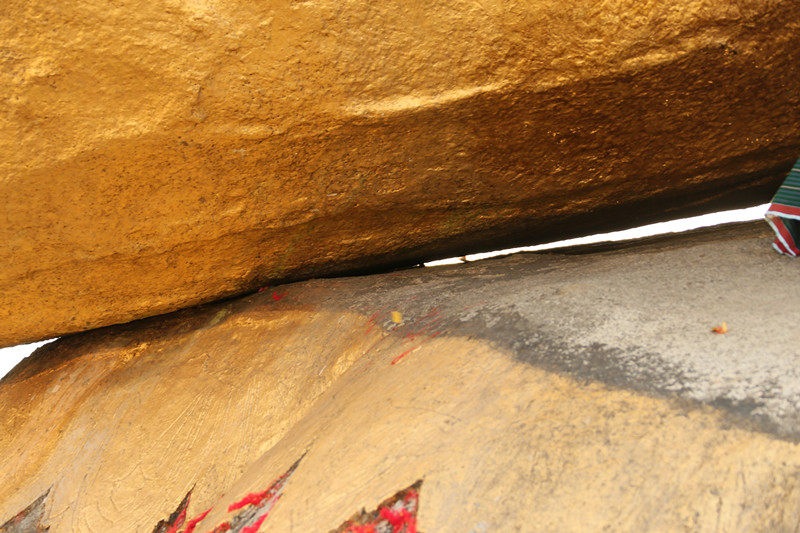
1975年,缅甸发生了全国性大地震。古都蒲甘的部分佛塔,在地震中倒塌,就连缅甸最神圣雄伟的仰光大金塔的宝伞也因地震而倾斜,而悬在峭壁边沿的风动石佛塔却奇迹般纹丝不动,没有任何损毁。
风动石是一个奇景,更是缅甸佛教徒一生必定朝拜的圣地,因为这块石头上有一座佛塔。相传两千多年前,有一位经商的缅甸人,去印度时皈依了佛陀,并领受了佛陀所赐的佛发。在这位商人离世之后,其中的三根佛发被起塔供奉在这里。
这个故事就是讲,当时佛陀菩提树下成道之后,第一个徒弟就是缅甸人。这个缅甸人就是经商到印度去,路过菩提伽耶,看到佛陀相貌庄严,威光合一,升起了这样子虔诚的心向佛陀请教。佛陀为他讲法,讲法了之后,他就拜佛陀为师。然后因为当时有了佛,商人听闻了佛陀的法,就在这个时候他成为二宝弟子。由于僧宝还不存在,这时候只有二宝弟子。商人听了法,满心欢喜,佛陀就拔下自己的头发,一共十六根头发送给他。你看这个皈依证很厉害吧?
所以他接了这个头发之后,就一路欢喜的回缅甸了。回来了之后,他就禀报给当时的皇帝,他说我在印度遇到了这样一位圣人而且还听到他的教。皇帝听了也特别激动高兴,然后当他呈现出这个头发的时候,皇帝说这应当起塔供养。“塔”在古代的时候就是对圣人的一种纪念,像纪念碑一样的。
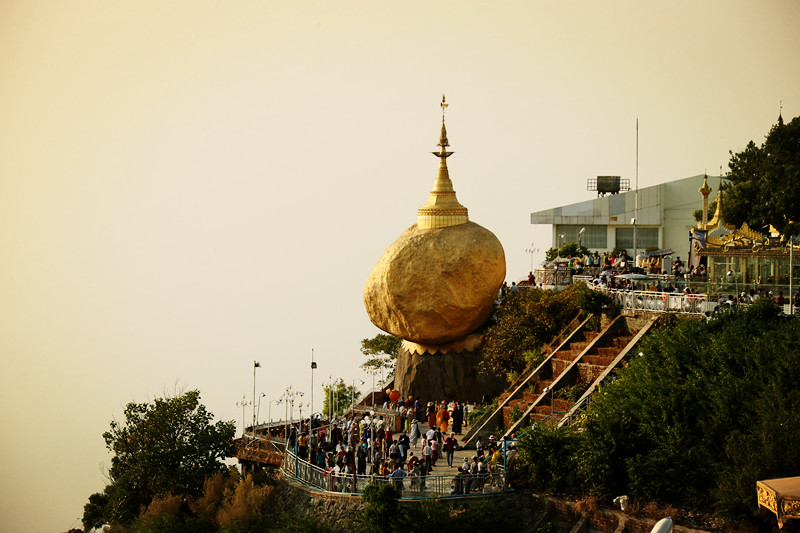
其中就供奉了三根头发,我们的风动石这里,矗立在悬崖边上的风动石。虽然与地面接触面积很小、甚至有随风摆动,摇摇欲坠的视觉,但是因为其上的佛塔内装藏有三根佛发。这三根头发却成为缅甸人心里安稳如山的力量源泉。
在公路还没有修好的时候,许多的缅甸人远足而来,花五六个小时的时间才能登上山顶朝拜佛塔和佛发。现在虽然有皮卡车的便利,但是仍有不少缅甸人采取步行登山的方式朝圣,用坚实的脚印来表达他们对佛陀虔诚的信仰。按照缅甸的习俗,一百多年来,风动石被不断地贴金,成为如今金黄璀璨的闪亮颜色。缅甸人坚信朝拜佛发就是朝拜佛陀真身。
来到风动石佛塔,就如同与佛陀处在了同一个时空,因此为了能在最近的距离、有更多的时间与佛陀在一起,前来朝圣的人都会在风动石下,不知疲厌地忙上整整一夜,有的通宵供灯,有的诵经拜佛,还有一些信众早早准备好食物预备供养僧人。从他们专注的投入中可看出,缅甸人对佛陀的虔诚可见一斑,那种身心全然的交付,那种纯粹没有掺假的真诚,两千年来从未改变。
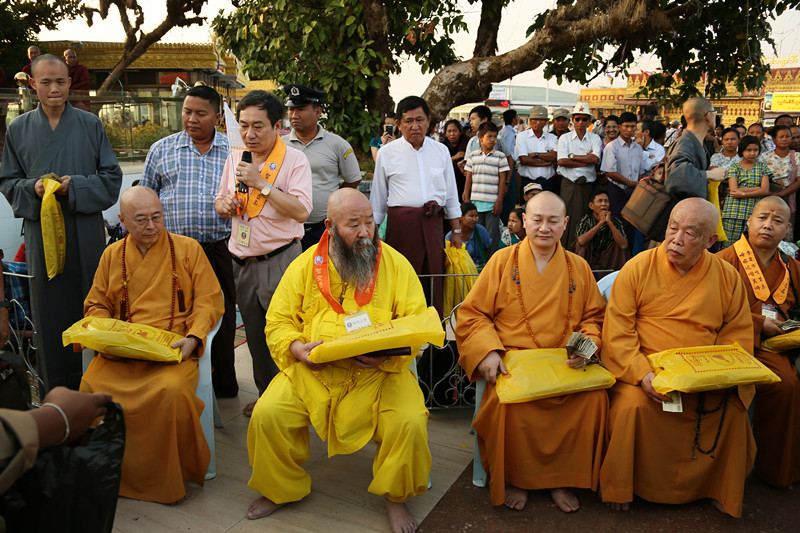
在风动石下,尊贵的海涛法师,传喜法师和普光长老带领弟子们举行了供袈裟的仪式。仪式简朴而又隆重,这些平日勤于修行难得一见的僧人,都是来自风动石附近的寺院,今天是特地出来应供的。三宝是众生的无上福田,袈裟是象征解脱的法服,来自中国的虔诚佛子们,跪地列队,带着欢喜和虔敬的心,精勤耕种福田,仔细地呵护着心田里的菩提幼苗,期盼着开花结果的一天,满满的功德回向给一切有情。
夜晚,法师们共同主持了点灯法会,与缅甸当地人一起点亮了9000盏油灯,忆念佛陀为我们的内心带来的光明。佛子们在风动石佛塔下,观想着燃烧的油灯就是我们的自我,愿无始以来的无明烦恼,点点燃尽,闪闪的火焰化作放光的红莲,照亮三界各个角落里的一切众生。
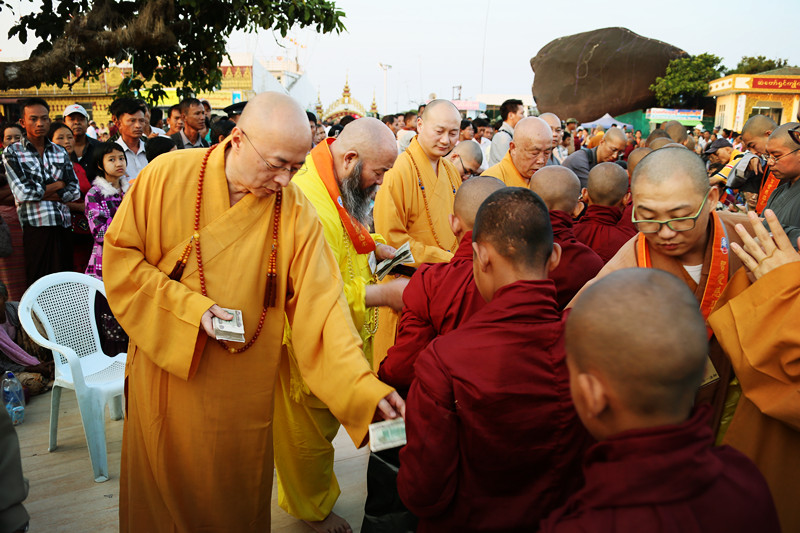
在风动石的第二天清早,曙光初露,迎面就走来一些托钵的僧人。传喜法师也带领弟子们,与缅甸人一起参与到供斋的行列。缅甸人虽然普遍并不富裕,但是却非常乐于施舍出家人,这种布施的行为贯穿在日常生活中,成为他们最重视和最值得骄傲的善行。南传佛教的出家人两千多年来,沿袭佛陀时代的传统,每天早上仅为一日之所需,而外出托钵化缘。同时,这也是僧侣们的一种修行方式,因为当他们外出化缘时,他们放下自我的傲慢,修习谦卑和感恩,并借此免除财物带来的贪婪和迷惑,培养一颗清净寡欲的心。
在缅甸路上随处可见,列队整齐的僧人外出托钵的场景。僧人们内敛安静的神态和施主们恭敬热情的表情,让我们仿佛又置身于遥远的佛陀时代。尊贵的法师们一行到来之际。佛子们在法师们的带领下朝圣,供僧、绕塔、点灯、施食、发菩提心和累积成佛的功德和资粮。每到一处圣地,我们都珍惜当下的每一个情境,精进无厌地修持。
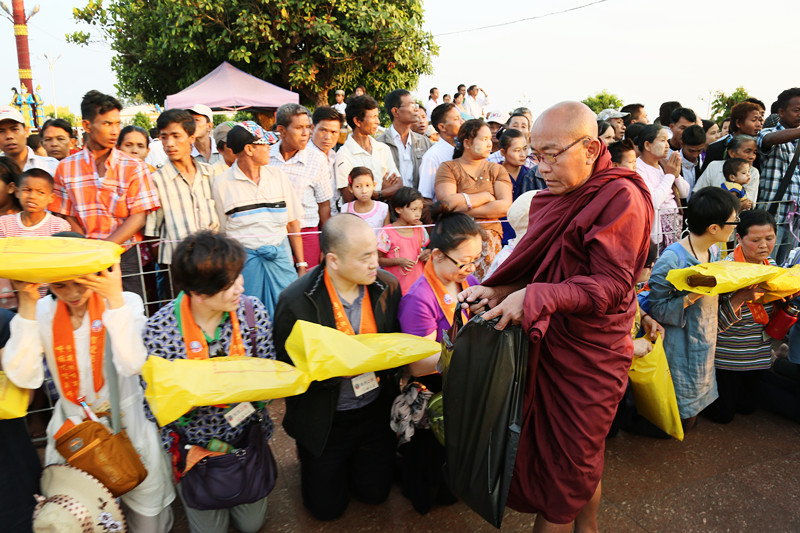
因为机缘的巧合与殊胜, 在风动石朝拜的行程中,众弟子们有幸瞻仰朝拜了珍贵的佛牙舍利,虔诚的缅甸信众闻讯而来,沿路跪拜。那纯朴的面容、永恒的虔诚与不变的信仰,远远的映衬着金色的风动佛塔。一切都是那么的自然而然,一切又是那么的动人心魂!
In such a devout Buddhist country (Myanmar), there are many sacred places to visit for the Buddhist pilgrims. Despite of the challenges, every year there are many people who travel to this country from different places afar to feel the blessings from the wisdom of Buddha and purity their body and soul.
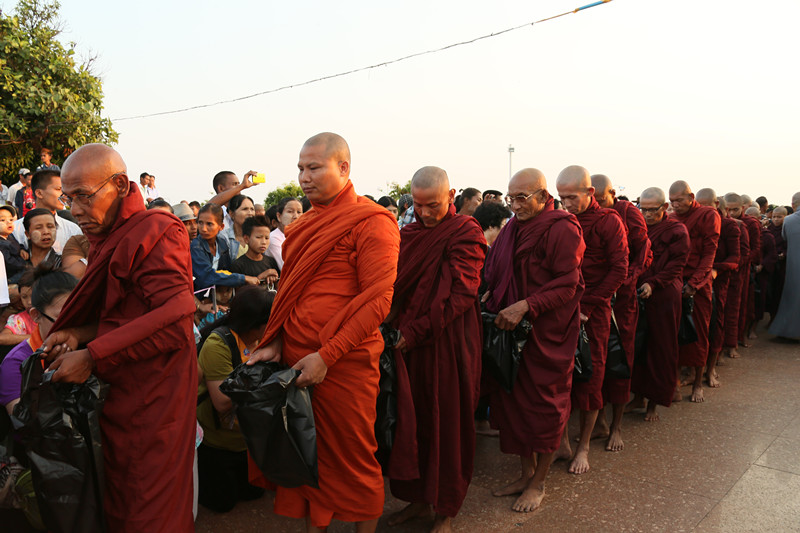
Kyaiktiyo Pagoda (Golden Rock) is located in Mon State at about a distance of 200km from Yangon, the capital of Myanmar. It takes about 4 to 5 hours by car. At the base of Mt. Kyaiktiyo, there is a narrow passage where only one car could pass through at a time. This passage is very steep and winding. Therefore, people must switch to an open-topped truck to reach the shrine.
According to some local people, the Golden Rock was re-discovered over a hundred years ago. There used to be very few people traveling to this faraway and isolated land. Looking afar, the boulder rests on a large natural rock platform of a cliff with an extremely small contact area. When the wind blows, it looks as if the rock is swaying with the wind. But, it will not fall. Under the rock, there used to be many small bamboo chips. The chips were placed there and people would gently push the rock. You could see the chips moving. I saw it with my own eyes. What does it prove? The rock and the platform are in two separate ‘pieces’.
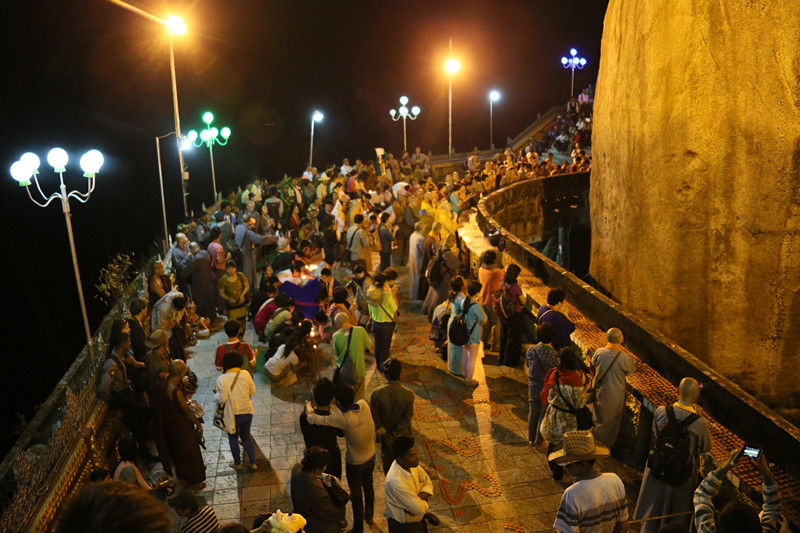
In 1975, there was a massive earthquake in Pagan, the ancient capital. Many monuments and pagodas were damaged including the holiest and most magnificent shrine, Shwedagon Pagoda. Its crown umbrella tilted due to the earthquake whereas the Golden Rock that was resting on the cliff miraculously remained intact.
The Golden Rock is an extraordinary site where a Burmese Buddhist must make a pilgrimage at least once in a life time due to a special pagoda sitting on the rock.
Apparently over two thousand years ago, there was a Burmese merchant who traveled to India, took refuge in the Buddha and was granted with a strand of His hair. According to the legend, the merchant was the first student of Buddha after He attained enlightenment. The merchant passed through Bodh Gaya and saw Buddha shining solemnly. A sense of devotion arose and he asked for His guidance. He then became the first disciple of Buddha. It was at that time he took refuge in the ‘two jewels’. During that time, the third jewel, Sangha, was not in existence. He was very happy after listening to the Dharma and the Buddha gave him a strand of His hair. What a unique ‘certificate of taking refuge’!
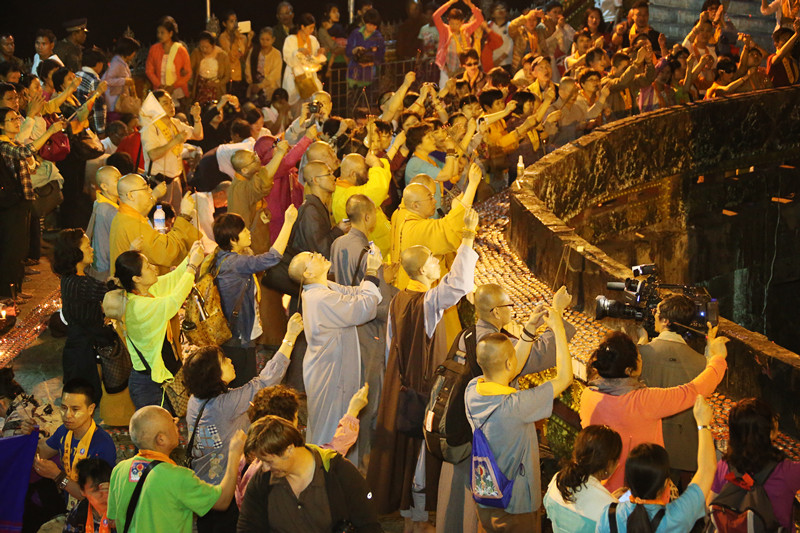
The merchant took the hair and went back to Myanmar happily. Upon arrival, he reported the incident to the King and said that he met an Indian sage: “I listened to His teachings”. The King also felt exceptionally happy. When Buddha’s hair was presented, the King ordered for it to be kept in pagodas. In the ancient time, pagoda served as a remembrance of sages just like statues of memorial.
It is in this place where some hair was kept. The pagoda was built right on top of the Golden Rock. Its surface sits on a tiny area of the rock and it looks as if it is swaying in the wind. It gives a visual effect as if the rock and pagoda might fall any time. This site has become one of the most powerful sources of mental strength in the heart of every Burmese. When the road was not built, many Burmese visited the place on foot which would take up to about 6 hours to reach the peak. Although there are open-topped trucks available, Burmese pilgrims still prefer to go on foot to complete their pilgrimage. Each and every sincere step that they take shows their devotion to the Buddha.
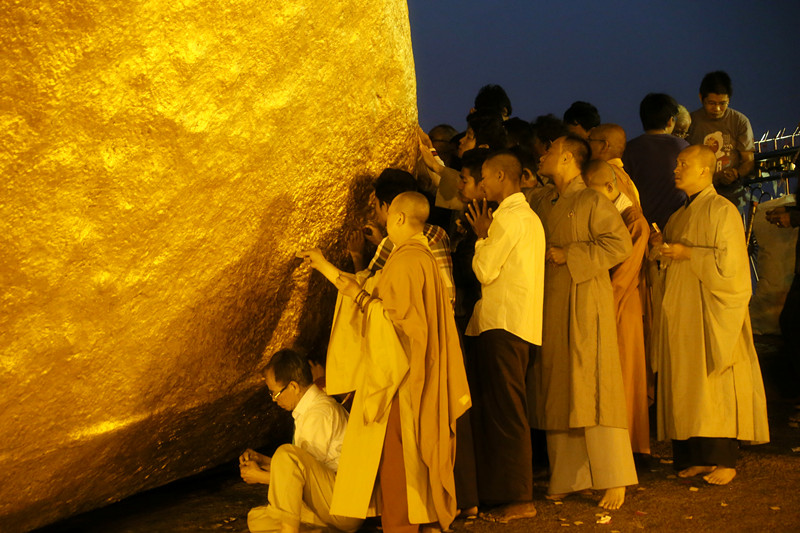
According to the tradition, there have been many people offering gold to be pasted on the rock over the past one hundred years. Now, it has become golden and shining. Burmese people truly believe that making pilgrimage to this pagoda where Buddha’s hair is enshrined is as good as visiting Him in person. It feels like being with the Buddha in the same dimension. Therefore, in order to ‘be near’ to the Buddha and ‘be with’ Him for longer, some pilgrims will stay up all night despite a hectic journey to reach the top of the mountain. They offer lamps, recite sutras and pray throughout the night. Others wake up early and prepare lots of good food to offer the monks and nuns. From their actions, we could feel the strong devotion of Burmese. It is a complete offering of body and soul without showing even a tiniest sense of pretension. This has not changed for over two thousand years.
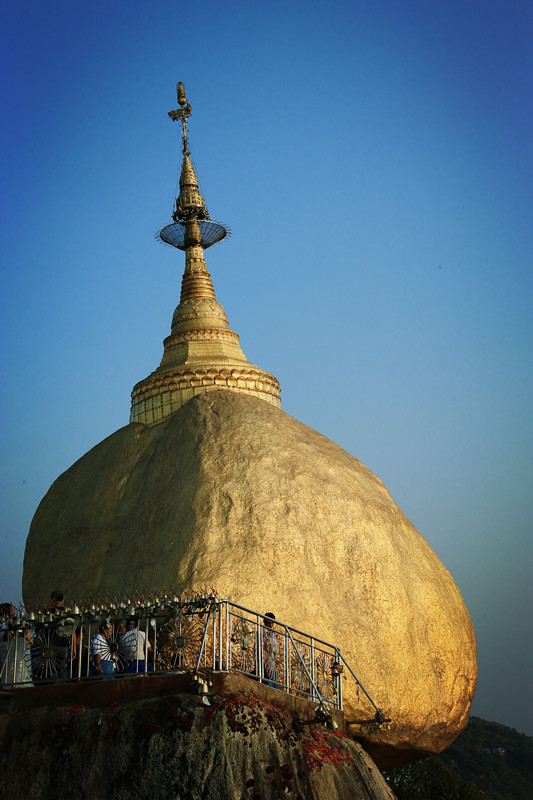
At the Golden Rock, the respected Master Haitao, Master Chuanxi and Venerable Master Puguang led their disciples to hold a simple and solemn ceremony of offering. The monks and nuns are usually very busy practising Buddhism and it is very difficult to meet them. They mainly come from temples nearby the Golden Rock. Today, they came here specially to receive offerings from us.
The third jewel, Sangha, is our supreme ‘land of fortune’. Kasaya is a symbol of liberation from the samsara. All the Buddhists from China kneeled down in a row with a heart filled with happiness and devotion. They are planting their ‘land of fortune’ and carefully protecting the bodhi seeds within their hearts hoping that one day they will all blossom beautifully. Eventually, all these merits will be dedicated to all sentient beings.
In the night, a ceremony of lamp offering was held with the local people. 9000 lamps were lit. This reminded us that Buddha brought brightness into our hearts. All the Buddhists were at the Golden Rock pagoda visualizing the brightness of the butter lamps became our ‘true self’ and hoping that our ‘true self’ would not be covered with worries and anxiety. The flames had turned into shining red lotuses and brightened every corner of the three realms.
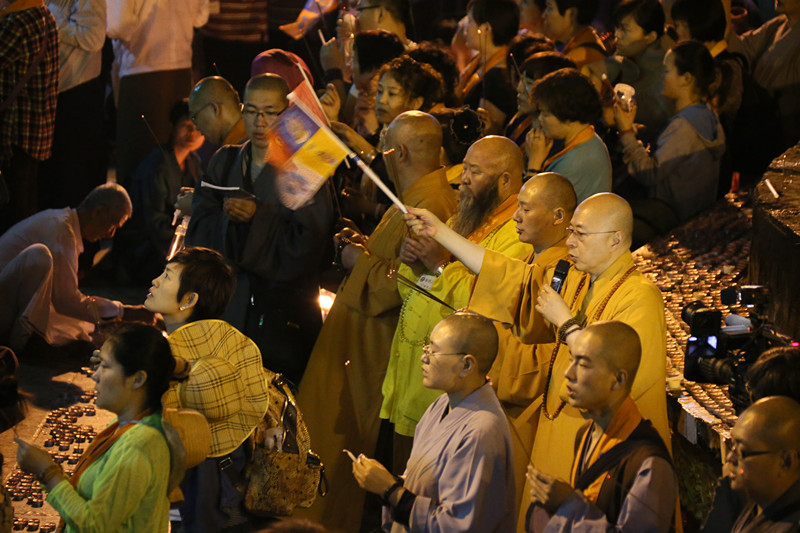
When the sun first rose and showered its sunshine on the Golden Rock in the next morning, there were some monks who came for offerings. Master Chuanxi led some disciples and local people to offer them vegetarian meals. Burmese are generally not rich, however, they are always very happy to provide offerings. This spirit of offering is completely integrated into their daily life and it is of the utmost importance to them. They feel very proud of carrying out such good deeds.
On the other hand, the monks who practice Hinayana Buddhism still follow the traditions dated back to the time of Buddha. They go out every morning to beg for alms that are only sufficient for the need of that day. In fact, this is a part of their practice. When a monk is out there begging for alms, he has to let go his ego and arrogance, and learn to be humble and grateful. It also helps to eliminate greed and illusion from the material wealth and cultivate a pure heart that is free from desires.

On every street in Myanmar, it is easily seen that monks who queue up neatly begging for alms. They are humble and calm while the alms givers are respectful and enthusiastic. These scenes seemed to have brought us back to the time of Buddha. During this whole Myanmar trip of pilgrimage, the masters were leading the Buddhists to provide offerings for the monks, go around the pagodas, light up butter lamps, awaken the bodhi hearts. All these are the merits and virtues of attaining Buddhahood. For every single holy place that we go, we should appreciate every moment that we have. We should persevere with our practice enthusiastically. Hope that the Dharma will bring brightness that illuminates like the sun and lead all the beings from this land to attain the ultimate noble truth of life.
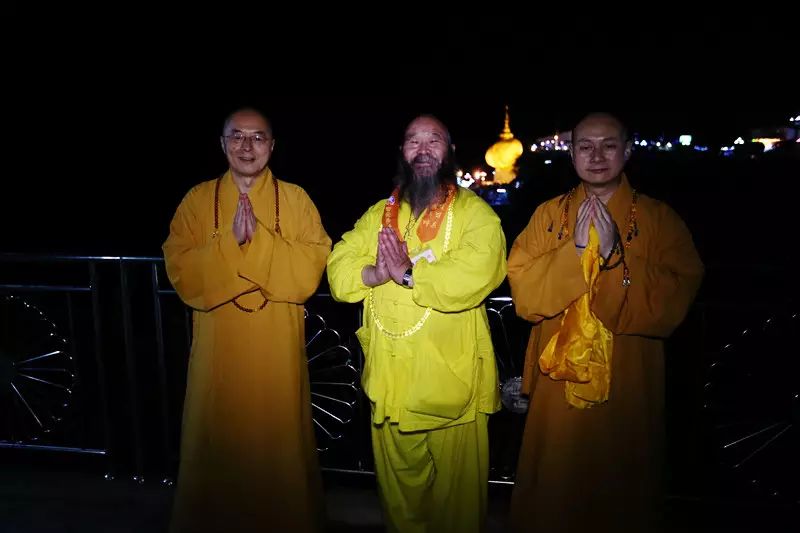
Due to many external factors and fate, we were lucky that during this trip we had a chance to make such a pilgrimage to the shrine of Buddha’s tooth relic as well. The devout Burmese Buddhists heard about our visit and showed their respect by kneeling down along the way. The most honest and sincere faces, the forever devotion that they have for their religion and the shining Golden Rock pagoda are all so natural… so natural that they touched the bottom of our hearts.
爱出者爱返,福往者福来。随喜转载,功德无量。
